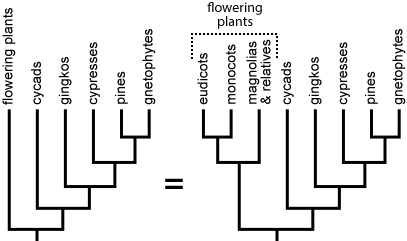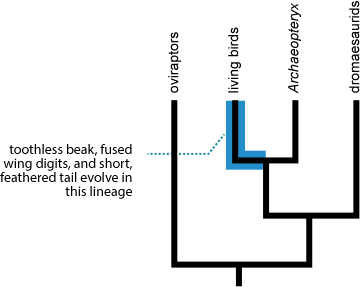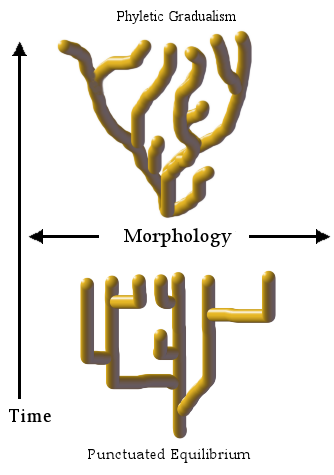Yes, it’s true—we’re coming to the end of our month of trees here at Misconception Monday. This week brings three more misconceptions to tackle, including the one that needles me the most as a paleontologist. I’m saving that one for last.
Misconception: A long branch that doesn’t split indicates that no evolutionary change has occurred along that lineage.
Correction: Whether a tree branch is shown as splitting depends in part on the purposes of the tree’s designer. In most trees, there is no correlation between branch length and amount of evolutionary change.
It’s tempting to think that the more branching there is going on in a tree, the more change is occurring—after all, the more branches there are, the more splitting events there are, and splitting events definitely represent change, right? Well, it’s true that splitting events definitely represent change, but remember that branches can be  expanded and collapsed to suit the purposes of the tree’s designer. Look at these two evolutionary trees. The tree on the left, for example, is showing the relationships among major groups of gymnosperms—plants that have seeds, but not flowers. In this tree, flowering plants are acting as the outgroup—they’re there to root the tree. Because the focus of this particular tree is the major groups of gymnosperms, the entire flowering plants group has been collapsed into one long branch. The tree on the right is exactly the same, except that the flowering plants group has been expanded a bit to show three of its subgroups. In this tree, the three flowering plant branches are shorter than the one long branch in the other tree, but the same exact amount of evolutionary change is represented.
expanded and collapsed to suit the purposes of the tree’s designer. Look at these two evolutionary trees. The tree on the left, for example, is showing the relationships among major groups of gymnosperms—plants that have seeds, but not flowers. In this tree, flowering plants are acting as the outgroup—they’re there to root the tree. Because the focus of this particular tree is the major groups of gymnosperms, the entire flowering plants group has been collapsed into one long branch. The tree on the right is exactly the same, except that the flowering plants group has been expanded a bit to show three of its subgroups. In this tree, the three flowering plant branches are shorter than the one long branch in the other tree, but the same exact amount of evolutionary change is represented.
Misconception: Evolutionary change only happens at nodes.
Correction: Nodes represent splitting events, but evolutionary change happens continually.
The explanation for the previous misconception works here, too. Because clades can  be expanded (increasing the number of nodes) or collapsed (decreasing the number of nodes), it cannot be true that change only occurs at nodes. Remember that trees are models of reality—the same amount of change has occurred within flowering plants whether a model shows all of its possible branches or not. But it’s important to note, too, that while lineage splitting events are significant, they do not represent the only moments of change within a group. Modern birds split from Archaeopteryx and its relatives at some point around 150 million years ago, but changes were building up before then, and continued to churn away after the actual divergence event.
be expanded (increasing the number of nodes) or collapsed (decreasing the number of nodes), it cannot be true that change only occurs at nodes. Remember that trees are models of reality—the same amount of change has occurred within flowering plants whether a model shows all of its possible branches or not. But it’s important to note, too, that while lineage splitting events are significant, they do not represent the only moments of change within a group. Modern birds split from Archaeopteryx and its relatives at some point around 150 million years ago, but changes were building up before then, and continued to churn away after the actual divergence event.
 This may all make you think of punctuated equilibrium vs. phyletic gradualism—is there any connection? Yes and no. Punctuated equilibrium and phyletic gradualism are hypotheses about the tempo of evolutionary change. According to the former hypothesis, change occurs primarily in short (on a geological time-scale) bursts followed by long periods of little-to-no change (“stasis”). According to the latter, change occurs at a steady, gradual rate. But while the rate may be different, the same amount of change, and branching, occurs in both models and there is plenty of fossil and genetic evidence for both in the history of life.
This may all make you think of punctuated equilibrium vs. phyletic gradualism—is there any connection? Yes and no. Punctuated equilibrium and phyletic gradualism are hypotheses about the tempo of evolutionary change. According to the former hypothesis, change occurs primarily in short (on a geological time-scale) bursts followed by long periods of little-to-no change (“stasis”). According to the latter, change occurs at a steady, gradual rate. But while the rate may be different, the same amount of change, and branching, occurs in both models and there is plenty of fossil and genetic evidence for both in the history of life.
Misconception: The only evidence worth using in constructing an evolutionary tree is molecular (e.g., DNA) evidence..
Correction: Morphology still matters.
 Back in my test-writing days, I loved to ask questions like, “How do scientists determine evolutionary relationships among fossil organisms?” Why? Because the answer is not DNA! What did most Massachusetts students say when they took the test? DNA, of course, but they were all wrong! MWAHAHAHA! Is DNA awesome? Yes! Has DNA helped us to clarify many troubling evolutionary relationships? You bet! But DNA has its limitations. Most notably, it has never been recovered from any fossil older than 700,000 years—no matter what Michael Crichton suggests—and even in younger fossils it is extremely unlikely to be preserved. So the only way to piece together evolutionary relationships among extinct species and between living and extinct species is by studying structure and function—morphology. So yes, DNA analysis (and analysis of other molecular evidence like RNA, proteins, and amino acids) is an unbelievably powerful tool that yields gigatons of data—but it is not the be-all-and-end-all of evidence for phylogenies. Also, take a moment to appreciate how far morphology alone got us. Up until recently, it was all scientists had, and they got a lot right without the benefit of Gs, As, Ts, and Cs. In fact, one of the best things about DNA analysis is that it has verified scores of hypotheses that were made based on morphology alone.
Back in my test-writing days, I loved to ask questions like, “How do scientists determine evolutionary relationships among fossil organisms?” Why? Because the answer is not DNA! What did most Massachusetts students say when they took the test? DNA, of course, but they were all wrong! MWAHAHAHA! Is DNA awesome? Yes! Has DNA helped us to clarify many troubling evolutionary relationships? You bet! But DNA has its limitations. Most notably, it has never been recovered from any fossil older than 700,000 years—no matter what Michael Crichton suggests—and even in younger fossils it is extremely unlikely to be preserved. So the only way to piece together evolutionary relationships among extinct species and between living and extinct species is by studying structure and function—morphology. So yes, DNA analysis (and analysis of other molecular evidence like RNA, proteins, and amino acids) is an unbelievably powerful tool that yields gigatons of data—but it is not the be-all-and-end-all of evidence for phylogenies. Also, take a moment to appreciate how far morphology alone got us. Up until recently, it was all scientists had, and they got a lot right without the benefit of Gs, As, Ts, and Cs. In fact, one of the best things about DNA analysis is that it has verified scores of hypotheses that were made based on morphology alone.
And that’s a wrap on trees! It’s also a wrap, for a while anyway, on my Misconception Mondays. I’m planning to take the summer off from them—but I’ll still be here regularly on the blog! I’ve got a bank of fossils to share, and there is never a lack of science communication to comment on. If there is something you want me to write about, please let me know. I’m always available via email, Twitter (@keeps3), and carrier pigeon.
All images, except where noted, are courtesy University of California Museum of Paleontology's Understanding Evolution (http://evolution.berkeley.edu).

